Velocity Structure Revealing a Likely Mud Volcano off the Dongsha Island, the Northern South China Sea
Abstract
:1. Introduction
2. Geological Setting
3. Seismic Data
3.1. OBS Data
3.1.1. Collection, Pre-Processing, Phase Picks, and Analysis
3.1.2. Velocity Inversion
3.1.3. Checkerboard and Resolvability
3.2. Multichannel Seismic Data Processing and Reflection Characteristics
4. Discussion
4.1. Phase Drop and Low-Velocity Zone
4.2. Velocity Structure and Sedimentary Layer Division
4.3. Analysis of the Hill H110 and the Low-Velocity Zone
4.4. Analysis of the High-Velocity Zone HVZ1
4.5. The Mechanism of Mud Volcano H110
4.6. Mud Volcanism and Petroleum Exploration in the CSD
5. Conclusions
- (1)
- A large, low-velocity (3.3–4 km/s) zone, found below the conic hill H110, corresponds spatially to the fractured zone of Mesozoic strata in the MCS profile, likely a fluid-rich fractured zone. Dredged samples from the H110 surface, containing rich organisms, as well clay minerals, such as illite, kaolinite, and chlorite, are indicative hydrocarbon seepage. Therefore, the conic hill H110, featuring an eruptive structure, can be inferred as a mud volcano.
- (2)
- A high-velocity (5.5–6.3 km/s) zone, which appears 7 km deep, under the low-velocity zone, is ascribed to magma intrusion. Thus, the mud volcanism at H110 may be thermodynamically driven by magma intrusion into the Mesozoic sedimentary layers, rich in organic matter.
- (3)
- The mud volcanism and remains of the large low-velocity zone, associated with the Mesozoic basin, implies an abundant hydrocarbon source and potential reservoir, thus a likely favorable clue for Mesozoic petroleum exploration.
Author Contributions
Funding
Data Availability Statement
Acknowledgments
Conflicts of Interest
References
- Mazzini, A.; Etiope, G. Mud volcanism: An updated review. Earth-Sci. Rev. 2017, 128, 81–112. [Google Scholar] [CrossRef] [Green Version]
- Mohammad, J.F.; Anne, O.; Matteo, L.; Karyono, K.; Adriano, M. The Plumbing System Feeding the Lusi Eruption Revealed by Ambient Noise Tomography. J. Geophys. Res. Solid Earth 2017, 122, 8200–8213. [Google Scholar]
- Somoza, L.; Díaz-del-Río, V.; Leόn, R.; Ivanov, M.; Fernández-Puga, M.C.; Gardner, J.M.; Hernández-Molina, F.J.; Pinheiro, L.M.; Rodero, J.; Lobato, A.; et al. Seabed morphology and hydrocarbon seepage in the Gulf of Cádiz mud volcano area: Acoustic imagery, multibeam and ultra-high resolution seismic data. Mar. Geol. 2003, 195, 153–176. [Google Scholar] [CrossRef] [Green Version]
- Dill, H.G.; Kaufhold, S. The Totumo mud volcano and its near-shore marine sedimentological setting (North Colombia)—From sedimentary volcanism to epithermal mineralization. Sediment. Geol. 2018, 366, 14–31. [Google Scholar] [CrossRef]
- Chen, C.S.; Hsu, S.K.; Wang, Y.; Chung, S.H.; Chen, P.C.; Tsai, C.H.; Liu, C.S.; Lin, H.S.; Lee, Y.W. Distribution and characters of the mud diapirs and mud volcanoes off southwest Taiwan. J. Asian Earth Sci. 2014, 92, 201–214. [Google Scholar] [CrossRef]
- Vogt, P.R.; Cherkashev, G.; Ginsvurg, G.; Ivanov, G.; Milkov, A.; Crane, K.; Sundvor, A.; Pimenov, N.; Egorov, A. Haakon Mosby Mud Volcano provides unusual example of venting. EOS Trans. AGU 2011, 78, 549–557. [Google Scholar] [CrossRef] [Green Version]
- Mazzini, A.; Etiope, G.; Svensen, H. A new hydrothermal scenario for the 2006 Lusi eruption, Indonesia. Insights from gas geochemistry. Earth Planet. Sci. Lett. 2012, 317–318, 305–318. [Google Scholar] [CrossRef]
- Milkov, A.V. Worldwide distribution of submarine mud volcanoes and associated gas hydrates. Mar. Geol. 2000, 167, 29–42. [Google Scholar] [CrossRef]
- Yan, P.; Wang, L.L.; Wang, Y.L. Late Mesozoic compressional folds in Dongsha Waters, the northern margin of the South China Sea. Tectonophysics 2014, 615–616, 213–223. [Google Scholar] [CrossRef]
- Hao, H.; Zhang, X.; You, W.; Wang, R. Characteristics and hydrocarbon potential of Mesozoic strata in eastern Pearl River Mouth Basin, Northern South China Sea. J. Earth Sci. 2009, 20, 117–123. [Google Scholar] [CrossRef]
- Zhong, G.J.; Yan, P.; Sun, M.; Yu, J.H.; Feng, C.M.; Zhao, J.; Yi, H.; Zhao, Z.Q. Accumulation model of gas hydrate in the Chaoshan depression of South China Sea, China. IOP Conf. Ser. Earth Environ. Sci. 2020, 569, 1–13. [Google Scholar] [CrossRef]
- Yan, P.; Wang, Y.L.; Liu, J.; Zhong, G.Z.; Liu, X.J. Discovery of the southwest Dongsha Island mud volcanoes amid the northern margin of the South China Sea. Mar. Pet. Geol. 2017, 88, 858–870. [Google Scholar] [CrossRef]
- Yan, P.; Deng, H.; Zhang, Z.; Jiang, Y. The temporal and spatial distribution of volcanism in the South China Sea region. J. Asian Earth Sci. 2006, 27, 647–659. [Google Scholar] [CrossRef]
- Taylor, B.; Hayes, D.E. Origin and History of the South China Sea Basin. In The Tectonic and Geologic Evolution of Southeast Asian Seas and Islands: Part 2; Lamont-Doherty Geological Observatory of Columbia University: New York, NY, USA, 1983. [Google Scholar]
- Lei, C.; Ren, J.; Pang, X.; Chao, P.; Han, X. Continental rifting and sediment infill in the distal part of the northern South China Sea in the Western Pacific region: Challenge on the present-day models for the passive margins. Mar. Pet. Geol. 2018, 93, 166–181. [Google Scholar] [CrossRef]
- Li, Y.; Abbas, A.; Li, C.-F.; Sun, T.; Zlotnik, S.; Song, T.; Zhang, L.; Yao, Z.; Yao, Y. Numerical modeling of failed rifts in the northern South China Sea margin: Implications for continental rifting and breakup. J. Asian Earth Sci. 2020, 199, 104402. [Google Scholar] [CrossRef]
- Wei, X.D.; Ruan, A.G.; Zhao, M.H.; Qiu, X.L.; Li, J.B.; Zhu, J.J.; Wu, Z.; Ding, W. A wide-angle OBS profile across Dongsha Uplift and Chaoshan Depression in the mid-northern South China Sea. Chin. J. Geophys. 2011, 54, 1149–1160. [Google Scholar]
- Wan, X.L.; Li, C.F.; Zhao, M.H.; He, E.Y.; Liu, S.Q.; Qiu, X.L.; Lu, Y.; Chen, N. Seismic velocity structure of the magnetic quiet zone and continent-ocean boundary in the northeastern South China Sea. J. Geophys. Res. Solid Earth 2019, 124, 11866–11899. [Google Scholar] [CrossRef]
- Christeson, G. OBSTOOL: Software for Processing UTIG OBS Data; University of Texas Institute for Geophysics: Austin, TX, USA, 1995. [Google Scholar]
- Zelt, C.A. Lateral velocity resolution from three-dimensional seismic refraction data. Geophys. J. Int. 1998, 135, 1101–1112. [Google Scholar] [CrossRef] [Green Version]
- Zelt, C.A.; Barton, P.J. Three-dimensional seismic refraction tomography: A comparison of two methods applied to data from the Faeroe Basin. J. Geophys. Res. 1998, 103, 7187–7210. [Google Scholar] [CrossRef]
- Yan, P.; Wang, Y.L.; Yu, J.H.; Luo, W.; Liu, X.J.; Jin, Y.B.; Li, P.C.; Liu, J.; Zhong, G.J.; Yi, H. Surveying mud volcanoes over the Dongsha Waters in the South China Sea. J. Trop. Oceanogr. 2021, 40, 34–43. (In Chinese) [Google Scholar]
- Lein, A.Y. Authigenic Carbonate Formation in the Ocean. Lithol. Miner. Resour. 2004, 39, 1–30. [Google Scholar] [CrossRef]
- Pevear, D.R. Illite and hydrocarbon exploration. Proc. Natl. Acad. Sci. USA 1999, 96, 3440–3446. [Google Scholar] [CrossRef] [PubMed] [Green Version]
- Milkov, A.V.; Vogt, P.R.; Crane, K.; Lein, A.Y.; Sassen, R.; Cherkashev, G.A. Geological, geochemical, and microbial processes at the hydrate-bearing Håkon Mosby mud volcano: A review. Chem. Geol. 2004, 205, 347–366. [Google Scholar] [CrossRef]
- Mavko, G.; Mukerji, T.; Dvorkin, J. Empirical relations. In The Rock Physics Handbook: Tools for Seismic Analysis of Porous Media; Cambridge University Press: Cambridge, UK, 2009. [Google Scholar]
- Raymer, L.L.; Hunt, E.R.; Gardner, J. An Improved Sonic Transit Time-To-Porosity Transform; Silverchair: Lafayette, LA, USA, 1980. [Google Scholar]
- Wyllie, M.; Gregory, A.; Gardner, L. Elastic wave velocities in heterogeneous and porous media. Soc. Explor. Geophys. 1956, 21, 1–209. [Google Scholar] [CrossRef]
- Gardner, G.H.F.; Gardner, L.W.; Gregory, A.R. Formation velocity and density-the diagnostic basics for stratigraphic traps. Geophysics 1974, 39, 770–780. [Google Scholar] [CrossRef] [Green Version]
- Larsen, H.C.; Mohn, G.; Nirrengarten, M.; Sun, Z.; Stock, J.; Jian, Z.; Klaus, A.; Alvarez-Zarikian, C.A.; Boaga, J.; Bowden, S.A.; et al. Rapid transition from continental breakup to igneous oceanic crust in the South China Sea. Nat. Geosci. 2018, 11, 782–789. [Google Scholar] [CrossRef]
- Sun, Q.; Wu, S.; Cartwright, J.; Wang, S.; Lu, Y.; Chen, D.; Dong, D. Neogene igneous intrusions in the northern South China Sea: Evidence from high-resolution three dimensional seismic data. Mar. Pet. Geol. 2014, 54, 83–95. [Google Scholar] [CrossRef]

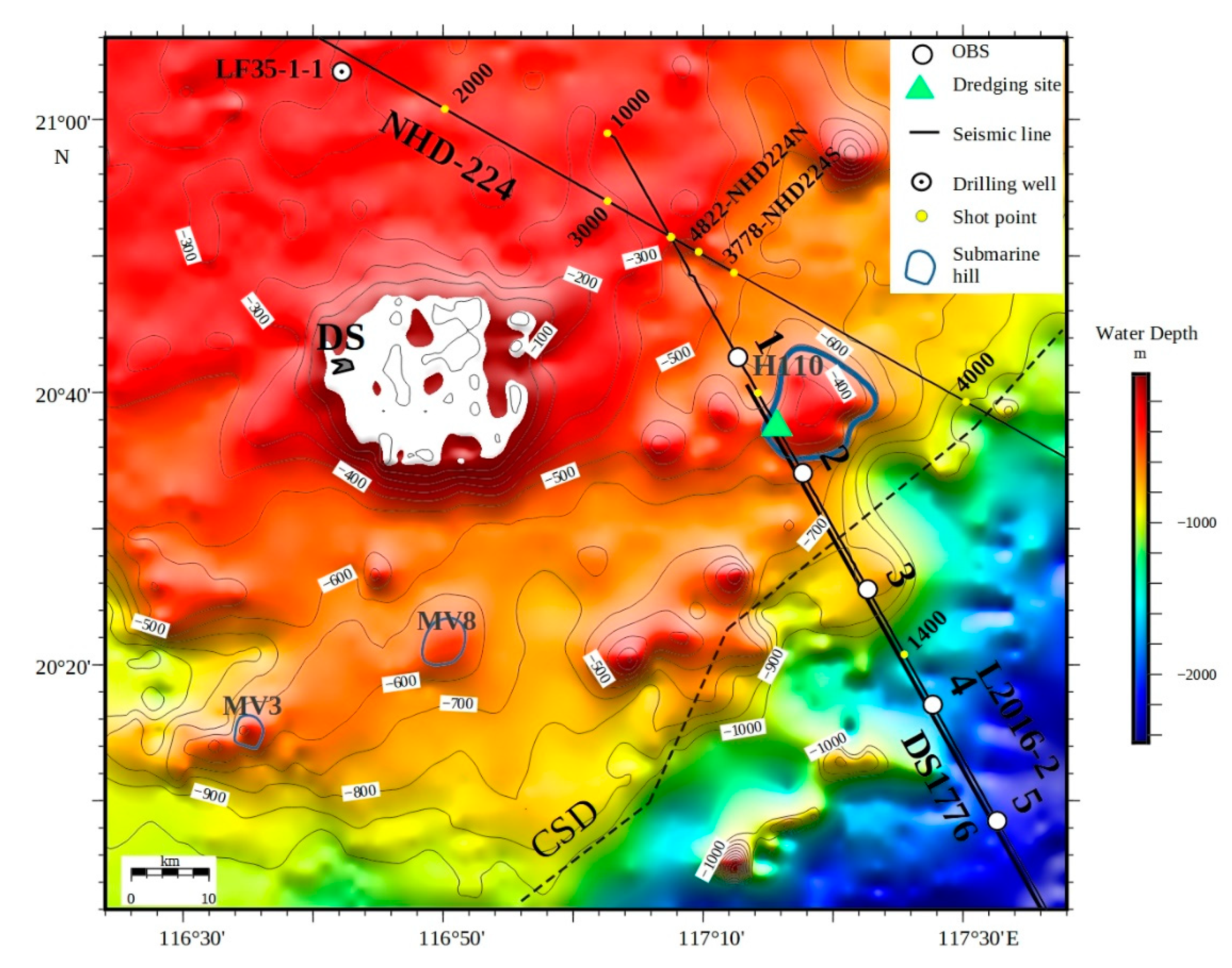
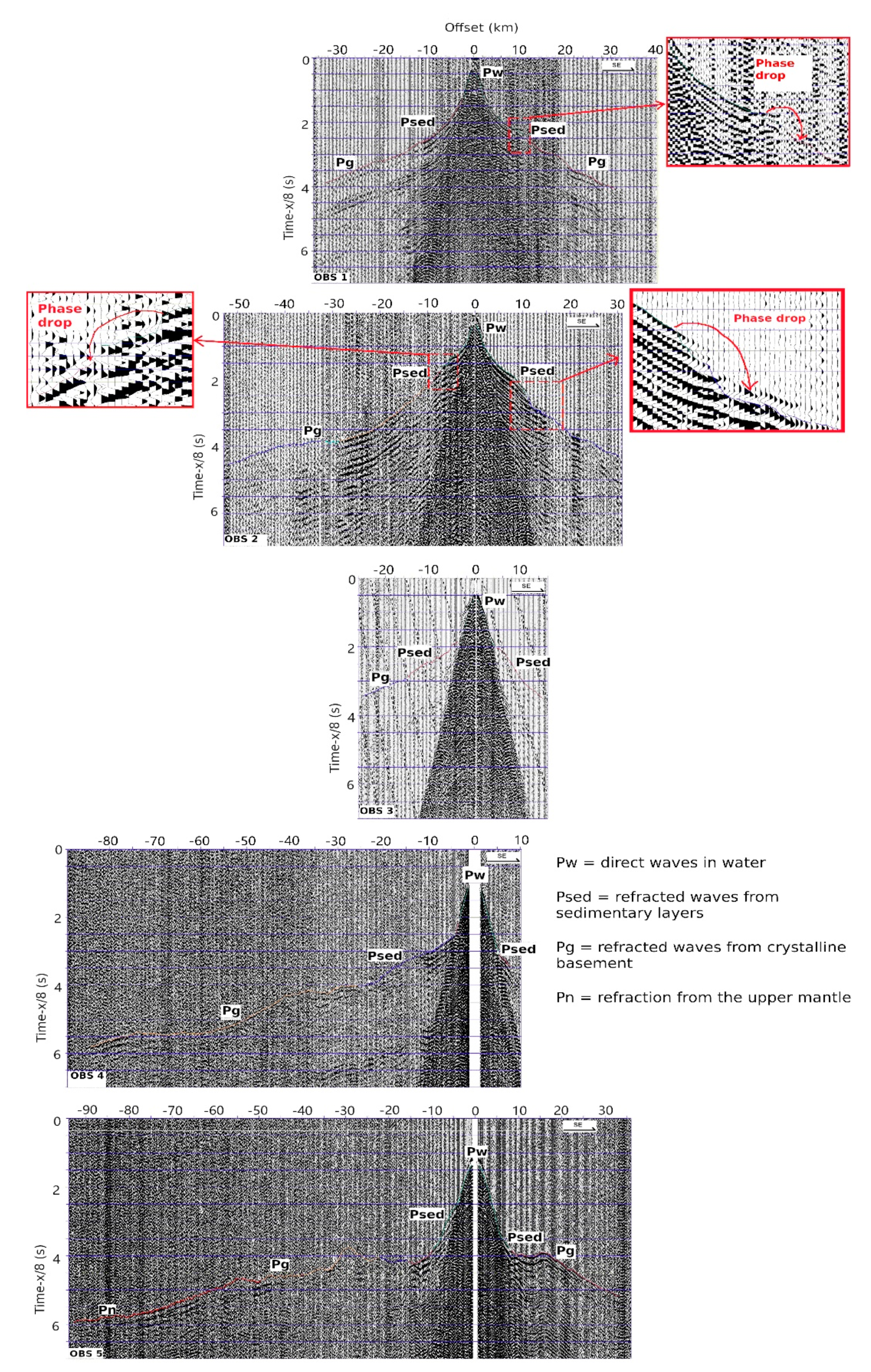

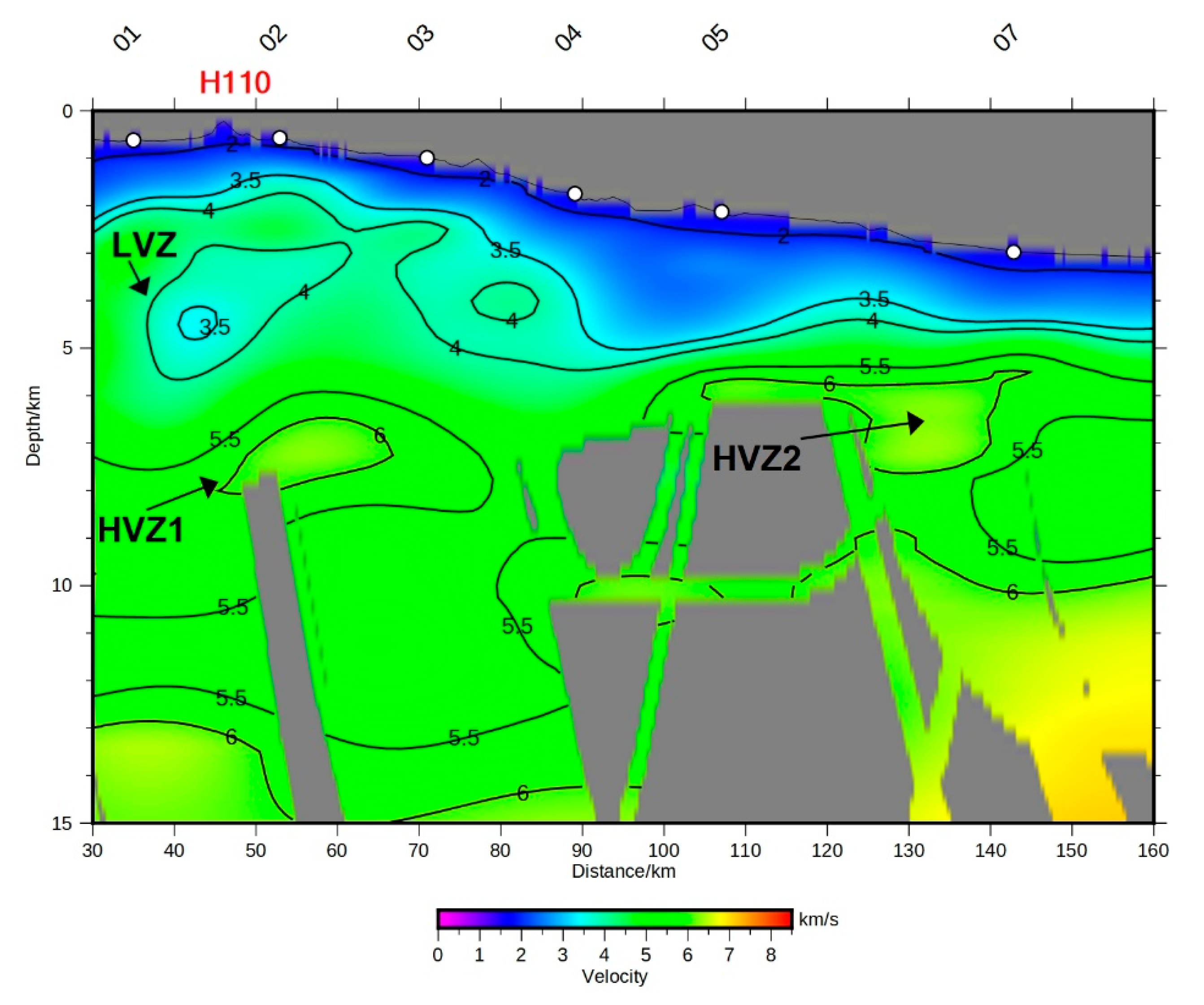


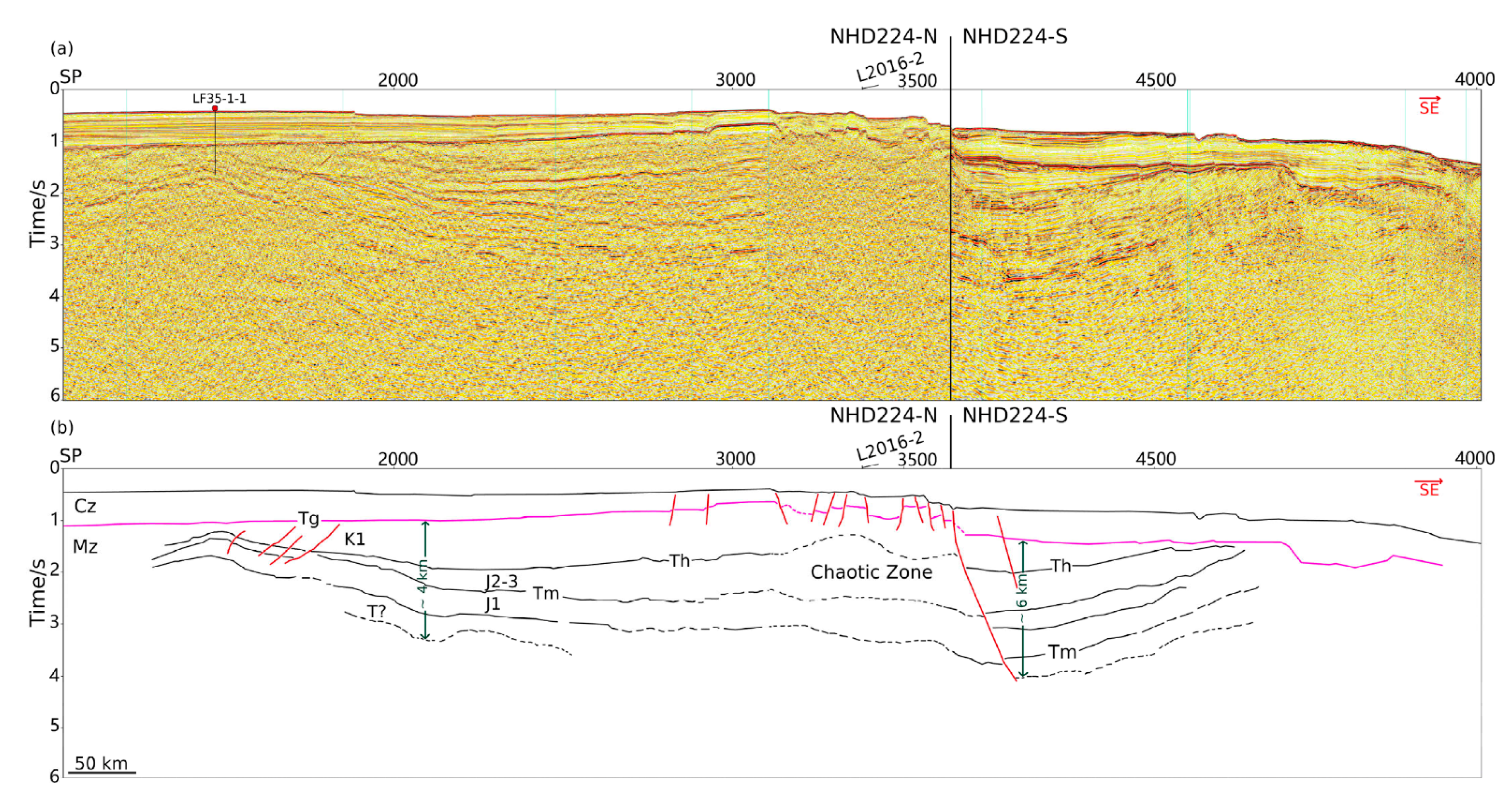
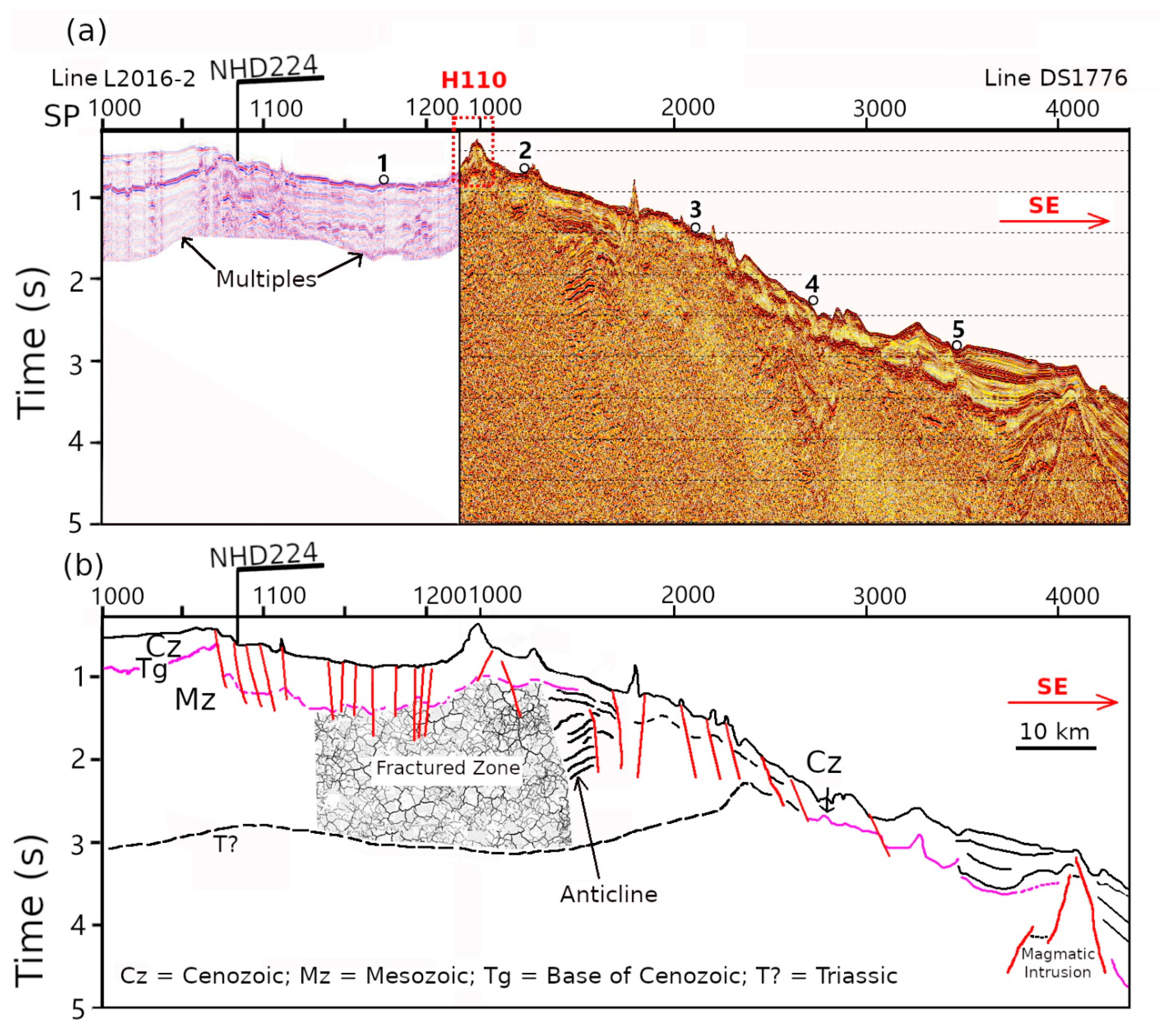

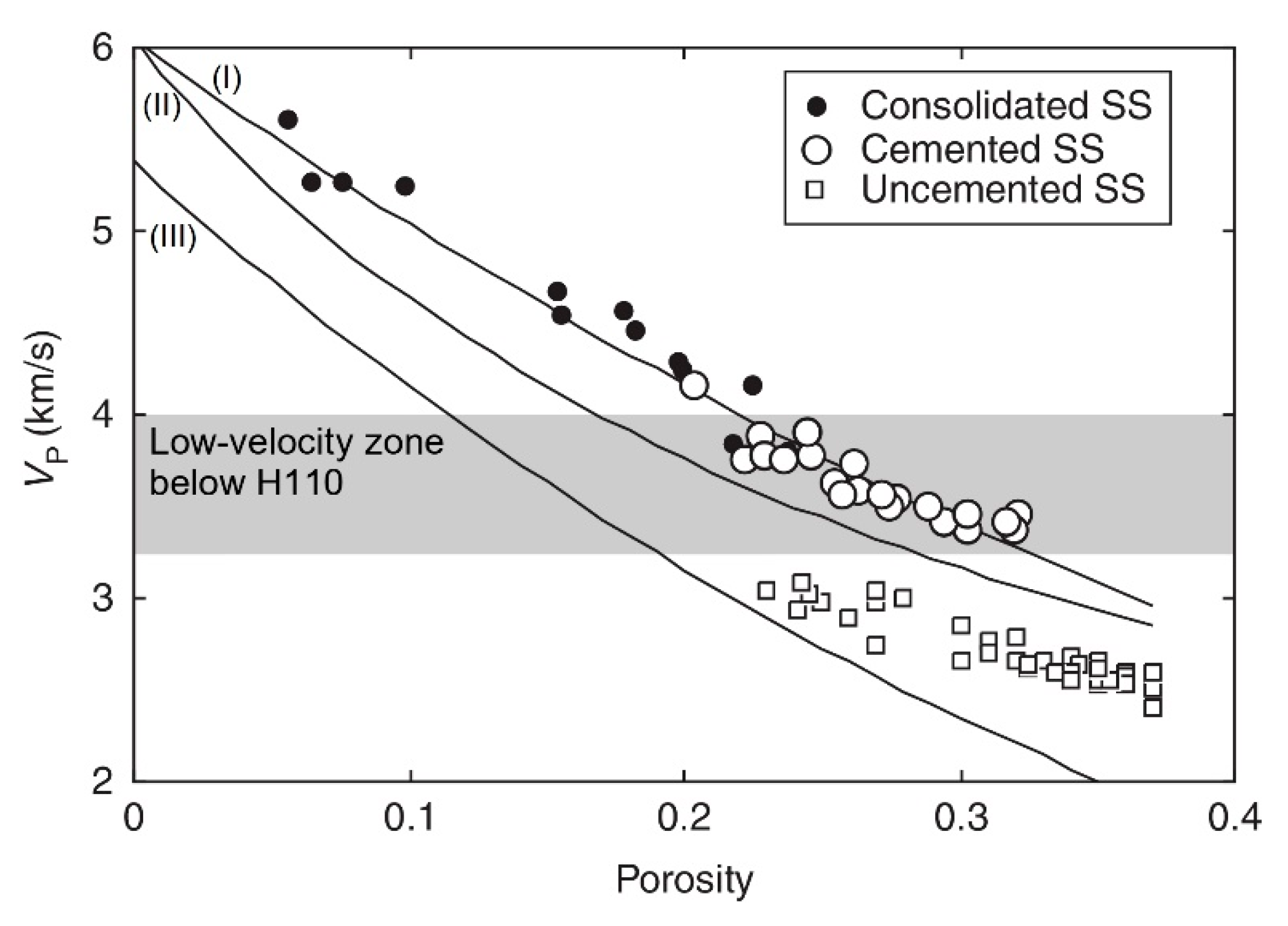
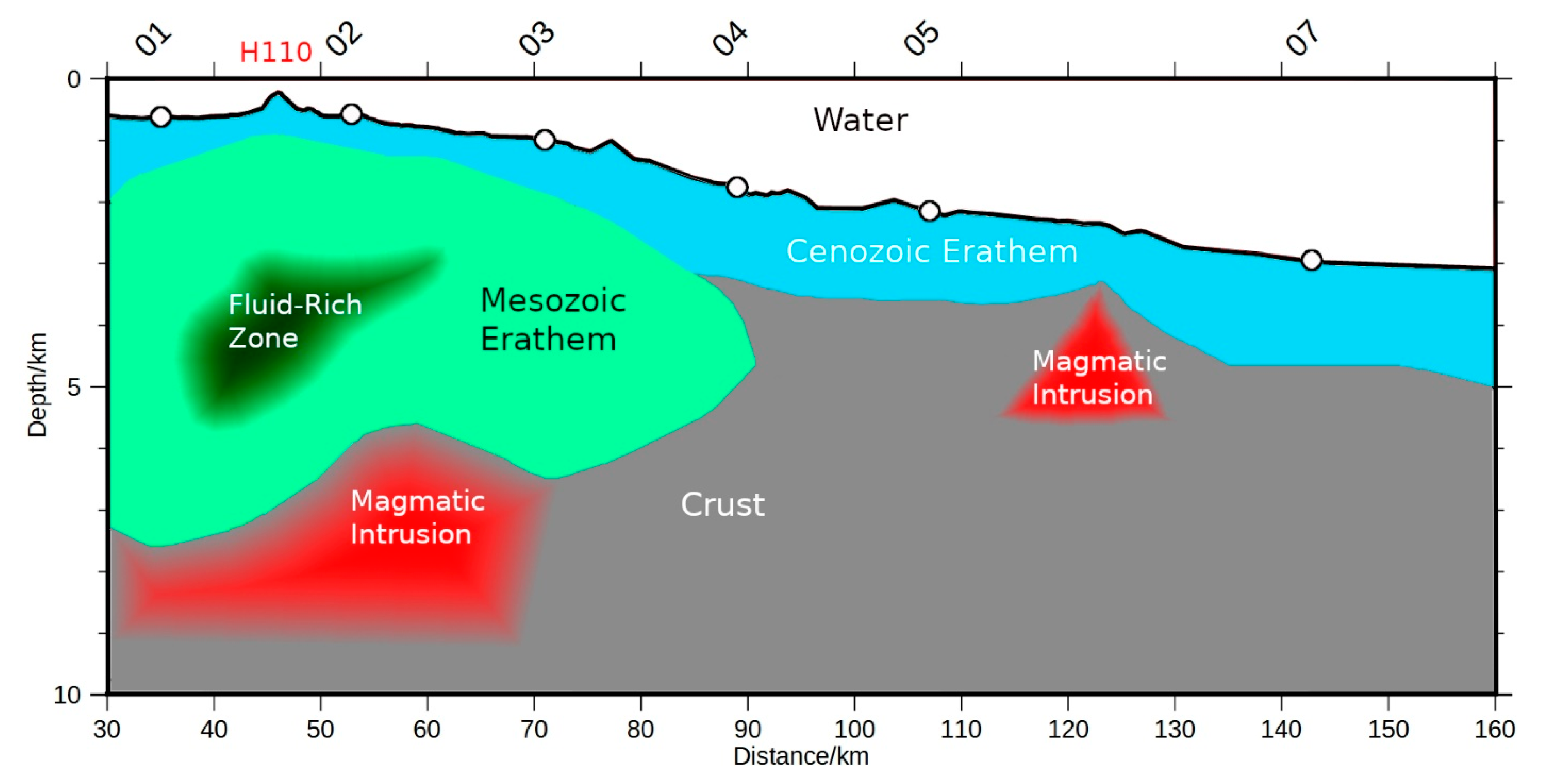
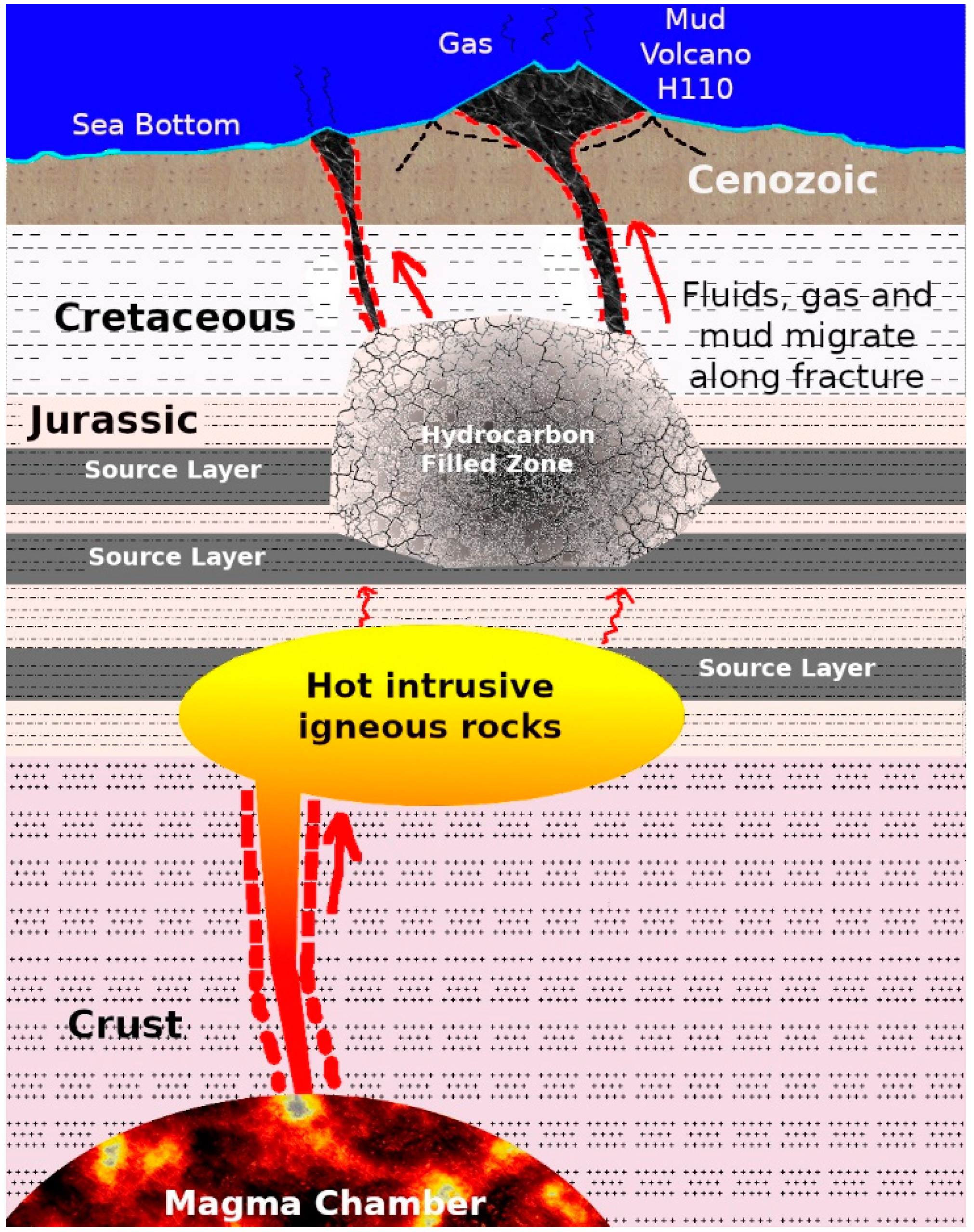
| Line Name | L2016-2 | NHD224-S | NHD224-N | DS1776 |
|---|---|---|---|---|
| Channels | 120 | 480 | 480 | 564 |
| Channel spacing (m) | 12.5 | 12.5 | 12.5 | 12.5 |
| Coverage | 4 | 60 | 120 | 141 |
| Shot spacing (m) | 200 | 50 | 25 | 25 |
| Minimum offset (m) | 200 | 250 | 250 | 200 |
| Sample interval (ms) | 2 | 2 | 2 | 1 |
| Record time length (s) | 14 | 12 | 9 | 8 |
| Source | 3 BOLT airguns | 32 BOLT airguns | 32 BOLT airguns | 40 BOLT airguns |
| Airguns Volume (in3) | 4500 | 5080 | 5080 | 4100 |
| Mineral | Ratio |
|---|---|
| illite | 14.50% |
| high-magnesian calcite | 36.00% |
| calcite | 31.80% |
| kaolinite | 3.10% |
| chlorite | 5.10% |
| quartz | 6.40% |
| iron-bearing dolomite | 3.00% |
Publisher’s Note: MDPI stays neutral with regard to jurisdictional claims in published maps and institutional affiliations. |
© 2021 by the authors. Licensee MDPI, Basel, Switzerland. This article is an open access article distributed under the terms and conditions of the Creative Commons Attribution (CC BY) license (https://creativecommons.org/licenses/by/4.0/).
Share and Cite
Yan, Y.; Liao, J.; Yu, J.; Chen, C.; Zhong, G.; Wang, Y.; Wang, L. Velocity Structure Revealing a Likely Mud Volcano off the Dongsha Island, the Northern South China Sea. Energies 2022, 15, 195. https://doi.org/10.3390/en15010195
Yan Y, Liao J, Yu J, Chen C, Zhong G, Wang Y, Wang L. Velocity Structure Revealing a Likely Mud Volcano off the Dongsha Island, the Northern South China Sea. Energies. 2022; 15(1):195. https://doi.org/10.3390/en15010195
Chicago/Turabian StyleYan, Yuning, Jianping Liao, Junhui Yu, Changliang Chen, Guangjian Zhong, Yanlin Wang, and Lixin Wang. 2022. "Velocity Structure Revealing a Likely Mud Volcano off the Dongsha Island, the Northern South China Sea" Energies 15, no. 1: 195. https://doi.org/10.3390/en15010195
APA StyleYan, Y., Liao, J., Yu, J., Chen, C., Zhong, G., Wang, Y., & Wang, L. (2022). Velocity Structure Revealing a Likely Mud Volcano off the Dongsha Island, the Northern South China Sea. Energies, 15(1), 195. https://doi.org/10.3390/en15010195






